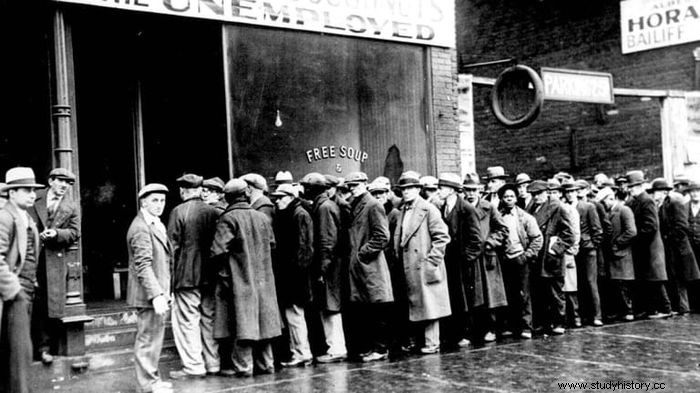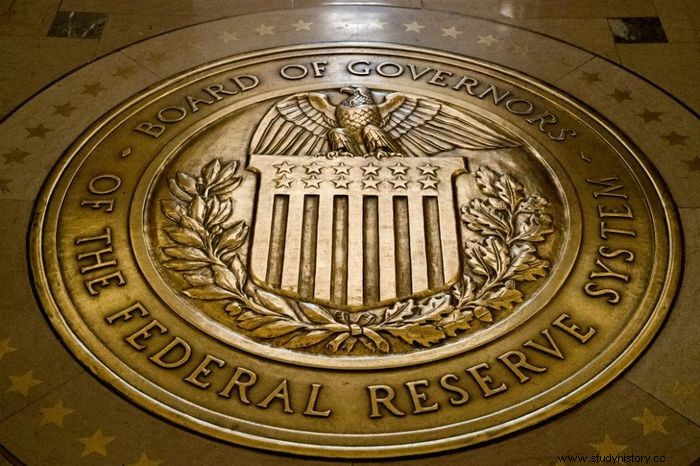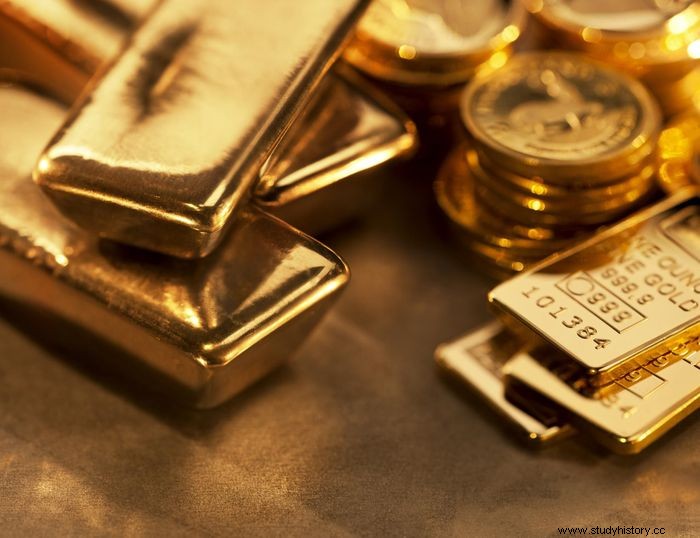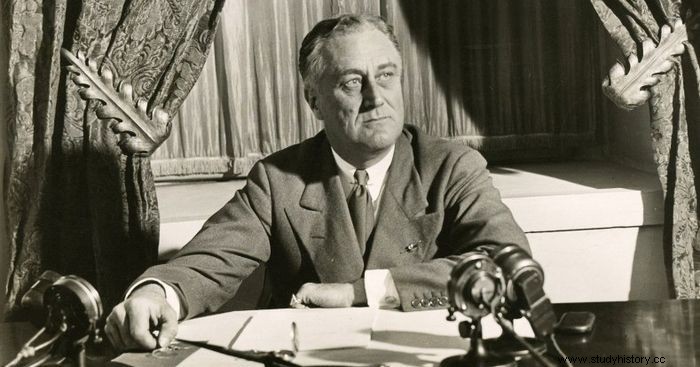In the late 1920's, market economies around the world were hit by a depression. Although the Great Depression was not so bad in some countries, it was terrible in others, especially in the United States. In the United States, 25% of all workers and 37% of all non-farm workers were out of work at the worst time in 1933. Some people died of starvation, and many others lost their farms and homes. People who lived on the streets snuck in on the freight trains all over the country. "Okies", who had lost his job as a cotton farmer, moved to California, hoping that the posters about many jobs were genuine.
Although the US economy began to improve in the second quarter of 1933, most of 1934 and 1935 saw little change. Finally, at the end of 1935, the economy began to improve. It continued to improve until 1937 when a new depression struck. When the United States joined World War II in December 1941, the economy had still not fully recovered from the Great Depression. Because of how long it took for things to get better, the 1930s were often referred to as the "Great Depression" in the United States.
The beginning of the Great Depression

The Great Depression was a decade of bad economic times around the world. It started in the United States on "Black Thursday", October 24, 1929. On this day, investors sold a record 13 million shares for fear. As a result, the Dow Jones index, a well-known indicator of the US stock market, fell by about 25% in just four days. It continued to decline for the next three years, and between October 1929 and July 1932 it lost almost 90 percent.
The stock crash significantly cut spending on consumers and corporate investment. So during the first years of the Great Depression, US GDP fell sharply, from $ 104.6 billion in 1929 to $ 57.2 billion in 1933. During the worst part of the recession, between 2008 and 2009, however, GDP fell by only 2%.
Stock market crash of 1929
The US stock market saw unique growth in the 1920s. As stock prices rose to levels never seen before, investing in the stock market became an easy way to make money. People with average incomes spent a lot of their extra money or even took out mortgages to buy shares. Hundreds of millions of shares were bought at margins at the end of the decade. However, margins meant that the cost of buying them was with loans that will be repaid with profits from the prices of the shares going up all the time.
So when prices began to fall in October 1929, which had to happen, millions of shareholders with too much debt panicked and rushed to sell their holdings, which made the fall worse and caused more panic. Share prices fell 33 percent from September to November. The result was a major shock to people's minds and a loss of faith in the economy for both consumers and businesses. So consumer spending, especially on long-term goods and corporate investment, was cut back a long way. This cut led to less industrial production and job losses, cut spending and investment even more.
Mistakes from a young central bank during the Great Depression
Before and after the crash of 1929, the Federal Reserve, which was not very old at the time, managed money and credit poorly. When it was first created in 1913, the Fed did not do much for the first eight years. After the 1920-1921 Depression ended and the economy improved, the Fed allowed the money supply to grow significantly. Between 1921 and 1928, the total amount of money grew by 28 billion dollars, or 61.8 percent. The amount of money in the banks increased by 51.1%, the amount in savings and loans increased by 224.3%, and the amount in net life insurance reserves increased by 113.8%. This increase occurred after 1917, when the Federal Reserve lowered the required reserves to 3 percent. Only $ 1.16 billion was added to the gold reserves through the Treasury and the Fed.
The Fed increased the money supply and kept interest rates low throughout the decade, which resulted in the rapid expansion that triggered the crash. Unfortunately, the growth of the money supply also generated most of the stock market and real estate bubbles. The Fed took the opposite action when the bubbles burst and the market plunged. They reduced the circulation of money by a third. Hopes of a rapid recovery have been shattered since this downturn made it difficult for many small banks to secure funding.
The Fed's tight grip during the Great Depression

Before the Feds, the bank panic usually ended in a few weeks. The largest private financial institutions would lend money to the strongest smaller institutions to prevent the system from falling apart. A similar thing happened during the panic in 1907, which happened 20 years ago. When panic sales sent the NYSE into a downward spiral and caused a bank run, investment banker JP Morgan stepped in. He got people on Wall Street to move money to banks that did not have enough money. Oddly enough, this panic led the government to start the Federal Reserve so it does not have to depend so much on individual financiers.
After "Black Thursday", the leaders of several New York banks tried to increase confidence by buying large blocks of blue-chip shares at prices that are higher than the market. Although these actions led to a brief rise in prices on Friday, panic sales resumed on Monday. Since 1907, the stock market has grown too large for such individual efforts to keep up. Only the Federal Reserve could keep the US financial system from falling apart.
Between 1929 and 1932, the Fed did not do this with cash injections. Instead, it did nothing and let the money fall and thousands of banks fail. At the time, banking laws made it difficult for institutions to grow and diversify enough to survive a race at the bank or a large number of people withdrawing their money. Although difficult to understand, the Fed's harsh response may have been because it feared that helping careless banks would only make them more careless with money in the future. As a result, some historians say that the Fed made the economy too hot and made things worse for an already miserable form economy.
Bank panic and shrinking money
Between 1930 and 1932, the United States had four prolonged bank waves of panic. During these times, many bank customers tried to withdraw their cash deposits at the same time for fear that their bank would not be able to repay them. Ironically, banking panic often causes the very crisis that customers try to avoid. A great fear can destroy banks that are doing well financially.
By 1933, one-fifth of the banks open in 1930 had failed. This reason led to the new government of Franklin D. Roosevelt declaring a "bank holiday" for four days, which was extended to three days later. During this time, all the country's banks were closed until they could show state inspectors that they were financially stable. Since fewer banks could lend money, it was only natural that consumption and business investment would decline. As a result of people keeping their money in cash, there was also less money available for lending.
Some researchers say the Federal Reserve exacerbated the problem by raising interest rates and reducing the money supply. They did this because they felt it was necessary to maintain the gold standard (see below), which linked the value of the US dollar and the currencies of many other countries to a fixed amount of gold. Because there was less money, prices fell, making lending and investing even less likely.
The Gold Standard Contribution

There is no doubt that the gold standard contributed to the global spread of the Great Depression, regardless of how it affected the money supply in the United States. As the US economy shrank and prices fell, it tended to have a trade surplus with other countries. This profit was because the Americans bought fewer goods from different countries, and exports were relatively cheap. Because of these imbalances, the United States received a large amount of foreign gold, threatening to devalue the currencies of nations whose gold reserves were depleted. So foreign central banks tried to fix the trade imbalance by raising interest rates, which led to falling prices and production and rising unemployment in these countries. As a result, the world economy, especially in Europe, declined as much as in the United States.
How Hoover coped with the Great Depression
President Hoover's first response to the economic downturn was based on his long-standing voluntary principles. These included his belief that the government should not be too involved in the economy and his idea that giving direct public support to individuals would weaken people's character. He also believed that it would make them less willing to work and make them dependent on government distributions. By 1931, Hoover had changed his mind about how the government should help the economy. In 1932, the Reconstruction Finance Corporation (RFC) gave banks, railroads, and other privately owned businesses permission to borrow $ 2 billion. In July of that year, the federal government donated $ 300 million to the country's first aid and public works projects.
But for many, these steps were not enough and came too late. Shantytowns with makeshift hovers, called "Hoovervilles" to ridicule the president's inaction in a crisis, appeared across the country in public parks and vacant lots when unemployed people who could not pay mortgages or rent were evicted from their homes. "Hoover flags" were trouser pockets that were pulled out to show that there was no money in them. People who were homeless and used newspapers to keep warm were called "Hoover rugs." Franklin D. Roosevelt was elected president in a landslide in November 1932. He received 57.4% of the vote, while Hoover received only 39.7%.
International lending and customs contributions to the Great Depression
In the late 1920s, as the US economy continued to grow, US banks stopped lending money to other countries. This stop was partly because US interest rates were high at the time. As a result, some countries that borrowed money, such as Germany, Argentina and Brazil, saw their economies shrink due to the downturn. This incident happened before the Great Depression in the United States began. Meanwhile, American farmers were harmed by overproduction and competition from European and other farmers, so they pressured Congress to introduce new tariffs on agricultural imports. In 1930, Congress passed the Smoot-Hawley Tariff Act, a broad law that imposed high tariffs (an average of 20 percent) on various agricultural and industrial goods. Several other countries took action in response to the law, leading to a drop in production and a decline in trade worldwide.
The New Deal by Roosevelt

When he was elected president in 1933, Franklin D. Roosevelt promised many significant changes. He started New Deal as a set of new domestic programs and laws never made before. They were to help American companies, reduce unemployment and protect the public.
It was loosely based on the Keynesian economy and said that the government could and should stimulate the economy. New Deal had big goals, such as building and maintaining the country's infrastructure, giving everyone a job and ensuring fair wages. The government tried to achieve these goals by controlling prices, wages and even the production of things.
Some economists say that Roosevelt did many of the same things that Hoover did, but on a larger scale. He focused strongly on price support and minimum wage, took the country away from the gold standard and made it illegal for people to keep gold coins and bullions. He made it illegal to run a business with a monopoly. In addition, he created dozens of new public works programs and other agencies to create jobs.
The Roosevelt administration paid farmers and ranchers to stop or cut back on their work. As a result, even though thousands of Americans demanded cheap food, one of the worst problems at the time was that surplus crops were wasted. Between 1933 and 1940, federal taxes increased by three times as much to pay for these programs and new ones as Social Security. In addition, special taxes, personal income taxes, inheritance taxes, corporate income taxes and a profit tax were raised.
The New Deal's Pros and Cons
The New Deal had concrete effects, such as reforming and stabilizing the financial system, which made people feel better about the future. In March 1933, Roosevelt closed banks for a week to stop panic attacks from bringing down institutions. After this, there was a plan to build a network of dams, bridges, tunnels and roads. These projects enabled federal work programs and put tens of thousands of people to work.
Although the economy began to improve, the improvement was not strong enough to say for sure that the New Deal was successful in pulling America out of the Great Depression. Keynesians say Roosevelt's plans to get the economy back on track through public spending did not go far enough. Others say that Roosevelt, like Hoover, may have made the depression last longer by trying to make things better immediately.
One study found that the New Deal caused the Great Depression to last seven years longer than it would otherwise have done. However, the economy may not have returned as quickly after 1929 as it did after other times. It was, for example, the first time most people lost a lot of money in the stock market. Roosevelt's new rules and regulations came so quickly and were so different that companies were afraid to hire people or put money into them. Some believe Roosevelt cared more about social welfare issues than creating a Keynesian-style macroeconomic stimulus package.
How World War II changed things
Around 1941 or 1942, it seemed as if the Great Depression ended abruptly. But if we look at the number of jobs and GDP, the depression ended just before the United States joined World War II. In 1940, there were 8 million people without work. In 1943, this number was just over 1 million. But more than 16 million Americans were forced to join the military and fight. During the war, several were without work in the private sector.
Due to shortages caused by rationing, the standard of living went down. Even the taxes increased a lot to pay for the war. As a result, from 1940 to 1943, private investment fell from $ 17.9 billion to $ 5.7 billion. In addition, private production fell by almost half. Although it is a mistake to say that the war ended the Great Depression, it put the United States on the path to recovery. The war made it easier to trade with other countries and put an end to price and wage controls. As a result, the government began to buy cheap products, creating a huge boost for the economy.
After the end of the war, private investment went from $ 10.6 billion to $ 30.6 billion in the first year. As a result, the stock market went on a bull run in just a few years.
The conclusion
The Great Depression happened because of a nasty mix of things, such as a Fed changing its mind, protectionist tariffs and the government's efforts to help the economy, which did not always go well. Of course, the change of these things could have happened to shorten or even eliminate this time. But even though people are still arguing about whether the interventions were right, many of the New Deal reforms, such as social security, unemployment insurance and farm subsidies, are still in place today. In addition, there is a strong supportive idea that the federal government should act when there is a national economic crisis. Moreover, this is one reason why people think of the Great Depression as one of the most important events in modern American history.
